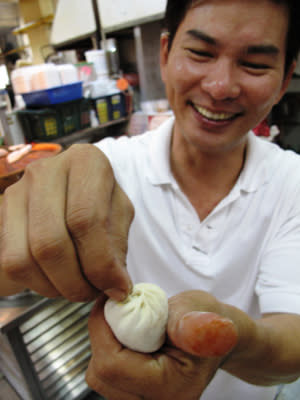Coffee-laced baos unique to Singapore

By K F Seetoh of Makansutra
The first question I had to ask as a curious culinary observer was: "Which is more important, the skin or the filling?" I had been enjoying the pleasures of stuffing a meat or vegetarian bao in my face long before I watched heroes like Tu Pi Dao (One Armed Swordsman) from wushu or swordfighthing movies slash their way to a tense meal stop in little towns infested with hoodlums. A plate of hot, steamed bao was always featured before the hero would throw one into the mouth of some blabbering gang leader spoiling for a fight. I always wondered what was in the bao.
"Of course it's the filling... it's the most important," calmly replied Loh Kok Leong, in an as-if-I-need-to-tell-you tone. Loh is one of those young-ish hawkers who decided long ago that since he loves dim sum and baos he should turn it into a business. He did so over 20 years ago. He paid his dues slaving away and learning under established dim sum sifus here, and at 41 years of age today, he's considered a young bao master.
"To the average heartland customer, the skin is just flour, they don't care how you make it, just as long it's not hard," he said, adding that "they see value in the fillings. It has to be tasty and not expensive." It helps that bao makers are creative, too. For as long as I can recall, baos were just about stuffing it with minced meat and turnips with an egg, chopped char siew or with tausa or red bean paste. The lian rong or lotus seed paste concept was borrowed from the mooncake craze.
Then came the inevitable creative approach. Someone started selling the three-stuffing baos, which had tausa, lian rong and salted egg yolk inside. Queues were forming at bao shops at Tanjong Rhu for it. It was a tad expensive and supplies were limited. It was the rage -- having a bao with soft smooth skin, paired with two sweet pastes countered with gently grainy and salty egg yolk. Divine. But just one of those can fill you up, and don't we know just how frustrating it is to ogle at the other dimsums with a filled tummy? So much baos, so little stomach space. So, the next idea that reeled them in was, well, mini baos.
"When I was an assistant bao maker, everyone I knew in the market was already selling it. Customers can buy a variety and not fill up that quickly. They could buy more and it wasn't necessarily at half the price of the big ones," Loh tells me, and he was quick to jump in on the bandwagon. He offered the range -- mini tausa, lian rong, char siew (all 50 cents each) and big meat baos ($1.20) with the usual siew mai (50 cents), lor mai fan (glutinous rice with chicken, $1.50) and fan choy (prepacked sauced rice with meat and vegetable, $1.50).
But those little baos weren't his main big sellers. "Some years back, people here were mixing lian rong with coffee and spiking the skin with a hint of coffee brown colour," he recalls. In that few minutes that I stood at his stall front spoiling for action and information, a steady stream of regulars in shorts and comfy home gear popped by to clear his steamers of little and big baos. Everyone ordered a few coffee baos (50 cents each). Some stood by patiently for that next batch to be ready.
Living up to his theory, the skins of his baos were thin, but not overly so. It was soft and, upon first bite, you can sense just how generous Loh is with his fillings. His mini char siew bao has a satisfying taste as he would rightfully use the marinated meats that had sat and breathed in the fridge for a night so that "the flavour will come out." His big baos are also popular and it had enough crunch from the turnips, bite from the meat and the quartered egg inside was perfect. I admit that some baos had skins which were inconsistently thin or thick, but you'll notice that they are all handmade on the spot and it's easy to get distracted and pressured when the impatient crowds come in. Most hit the spot. His mini coffee baos was a delight. It was oozing with dark brown coffee-laced sweet lian rong paste and very smooth and soft, not lumpy like some. You just need a cup of kopi o kosong (black unsweetened coffee) to go with it.
I realised that the baos those swordsman ate were actually mantous, the Adam and Eve of baos in China -- with no stuffing. No wonder they did not think twice throwing them at enemies.
Home-Make Pau Specialist |
Address |
Operating hours |
This post was first featured on Makansutra.
Photojournalist K F Seetoh is the founder of Makansutra, a company devoted to touting all the empirical wonders of Asian food culture. He writes a food guide, hosts his own Makansutra TV shows, manages food villages, creates online and mobile content, consults and operates award-winning food safaris. Yeah, in short, he eats, talks, documents and regales about food and sells coffee, sometimes while his mouth is full. CNN dubs him the 'Guru of the Grub' and The New York Times says he's 'the food guide maven'.


